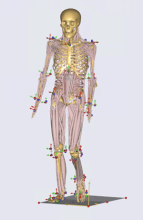Musculoskeletal models, like all theoretical models of physical processes, depend on the assumptions needed to construct the model. For musculoskeletal models, these assumptions include, among other things, the kinematic data, the kinetic data and the muscle parameters. The former (dynamic) data can be acquired relatively easily from living subjects, but the latter are usually based on limited information, frequently determined from cadaver studies performed on elderly individuals. Previously, we determined the sensitivity of forces to dynamic differences among 10 humans walking on a straight path. Here, we assess the sensitivity of the muscle and joint reaction forces developed in human walking to variable muscle parameters obtained from 10 living adults, whose data were recently reported, and compared the results with the values from a standard model that depends on cadaveric data. We found that, while the force patterns across the stance cycle were similar among muscle parameter models, differences of as much as 15% in the force magnitude were produced. Whether or not the variation between the standard model and other muscle parameters is important depends on why the forces are required.
Sensitivity of musculoskeletal models to variation in muscle architecture parameters
Kramer PA, Feuerriegel EM, Lautzenheiser SG, Sylvester AD. (2022) Sensitivity of musculoskeletal models to variation in muscle architecture parameters. Evolutionary Human Sciences, 4:1-17. doi:10.1017/ehs.2022.6
View PDF
(613.25 KB)
